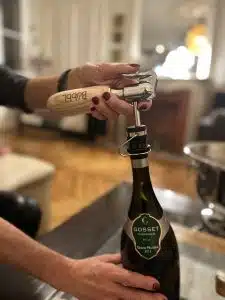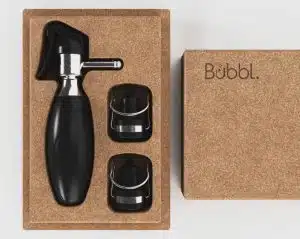Introduction:
Brut champagne , the epitome of celebration and sophistication, transcends being merely a beverage. It embodies a legacy of craftsmanship, history, and an enduring symbol of luxury. Originating from the Champagne region of France, this sparkling wine has captivated connoisseurs and casual drinkers alike for centuries. Let’s embark on a journey to uncover the essence of Champagne, its rich history, meticulous production process, and the art of appreciating its effervescence. Additionally, we will explore how Wikeeps, an innovative wine preservation and dispensing system, elevates the Champagne experience.
The origins and history of champagne:
Champagne’s storied history dates back to the Roman era when vineyards were first established in the region. However, it wasn’t until the late 17th century that the méthode champenoise, or traditional method, was perfected, giving rise to the sparkling wine we cherish today. Dom Pérignon, a Benedictine monk, is often credited with refining the techniques that enhance Champagne’s effervescence and flavor. His contribution, along with the dedication of countless vintners over the centuries, has cemented Champagne’s reputation as the pinnacle of sparkling wines.
The unique terroir of champagne:
The Champagne region’s unique terroir plays a pivotal role in defining the character of its wines. The chalky soil, cool climate, and specific vineyard locations contribute to the distinct minerality and acidity that Champagne is renowned for. These elements, combined with strict regulations governing vineyard practices and production methods, ensure that each bottle of Champagne reflects the essence of its origin.
The art of production:
Champagne production is a meticulous and labor-intensive process. It begins with the careful selection of grapes, predominantly Chardonnay, Pinot Noir, and Pinot Meunier. The journey from vine to bottle involves several key stages:
- Harvesting and pressing: Grapes are harvested by hand to ensure the highest quality. They are then gently pressed to extract the juice, with minimal skin contact to maintain the wine’s delicate character.
- First fermentation: The extracted juice undergoes primary fermentation, transforming it into still wine.
- Blending: The still wines from different vineyards and grape varieties are expertly blended to achieve the desired house style.
- Second fermentation: The blend is bottled with a mixture of sugar and yeast, triggering a second fermentation. This crucial stage creates the characteristic bubbles of Champagne.
- Aging: The bottles are aged on lees (dead yeast cells) for a minimum period, enhancing the complexity and richness of the wine. Non-vintage Champagnes require at least 15 months, while vintage Champagnes must age for a minimum of three years.
- Riddling and disgorging: The bottles are gradually turned and tilted (riddling) to collect sediment in the neck, which is then removed (disgorging) before sealing the bottle with a cork.
Understanding champagne styles:
Champagne offers a diverse range of styles to suit various palates and occasions. These include:
- Brut: The most popular style, characterized by its dry taste and minimal sugar content.
- Blanc de blancs: Made exclusively from Chardonnay grapes, known for its elegance and finesse.
- Blanc de noirs: Crafted from Pinot Noir and Pinot Meunier, offering richer and fuller flavors.
- Rosé: Distinguished by its pink hue, achieved through skin contact with red grapes or blending with red wine.
The Wikeeps innovation:
Wikeeps revolutionizes the way Champagne and other fine wines are enjoyed by ensuring optimal preservation and serving. This patented system, designed for wine professionals and enthusiasts, is based on enological gas technology. Wikeeps uses a neutral and inert natural gas—a blend of Argon and CO2 produced by Linde, the world leader in oenological gases.
The Wikeeps system injects this gas into the bottle, preserving the wine’s organoleptic properties while allowing it to be served by the glass. This food-grade gas creates a protective atmosphere inside the bottle, safeguarding the wine from oxidation. As a result, Champagne retains its qualities and aromas for up to four weeks after opening.
Wikeeps’ functionality is multifaceted: it elegantly pours wine without tilting the bottle, filters sediments, aerates the wine, and preserves it through the injection of enological gas. This innovation has garnered acclaim from sommeliers worldwide and has become a favorite among wine lovers.
The ritual of enjoyment:
Appreciating Champagne involves more than just drinking it; it’s about engaging the senses. Serve it chilled, ideally between 8-10°C, in a tulip-shaped glass to capture the aromas. Take a moment to observe the bubbles, inhale the bouquet, and savor the complex flavors on your palate. Champagne pairs beautifully with a variety of food
Discover our range of system now!
Conclusion:
Champagne remains an enduring symbol of celebration, luxury, and craftsmanship. Its journey from the vineyards of Champagne to the clinking of glasses worldwide is a testament to the dedication and passion of its producers. With the innovative Wikeeps system, wine enthusiasts can now preserve and enjoy their Champagne with enhanced ease and elegance. As you raise your next glass of Champagne, take a moment to appreciate the history, artistry, and sheer joy encapsulated in every effervescent sip.
FAQs:
1. What makes champagne different from other sparkling wines?
Champagne is unique due to its specific production method, known as méthode champenoise, and its origin in the Champagne region of France. This region’s terroir, with its chalky soil and cool climate, contributes to Champagne’s distinct flavor and effervescence.
2. How long can champagne be stored after opening?
With the Wikeeps system, Champagne can retain its qualities and aromas for up to four weeks after opening, thanks to the injection of enological gases that prevent oxidation.
3. What are the primary grape varieties used in champagne production?
The main grape varieties used in Champagne production are Chardonnay, Pinot Noir, and Pinot Meunier. These grapes are often blended to create the desired house style.
4. How should champagne be stored?
Champagne should be stored in a cool, dark place, ideally between 10-12°C (50-54°F), with a consistent temperature. Storing on its side helps keep the cork moist and maintains its seal.
5. What is the ideal serving temperature for champagne?
The ideal serving temperature is between 8-10°C (46-50°F). Chilling the bottle in an ice bucket for about 20 minutes or in the refrigerator for a few hours will achieve the perfect temperature.
6. Can Wikeeps be used for still wines as well?
Yes, Wikeeps is designed for both sparkling and still wines. Its innovative system preserves the wine’s organoleptic properties, ensuring that each glass tastes as fresh as the first.
7. How does Wikeeps preserve wine?
Wikeeps uses a blend of Argon and CO2, produced by Linde, to create a protective atmosphere inside the bottle. This prevents oxidation and maintains the wine’s quality for up to four weeks after opening.


